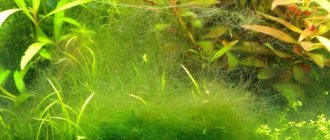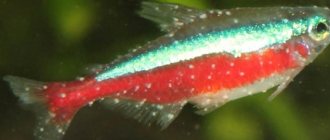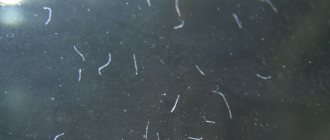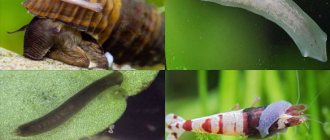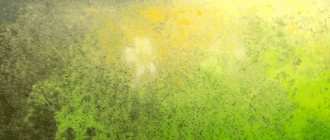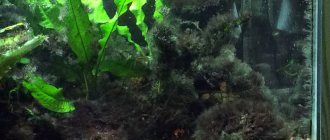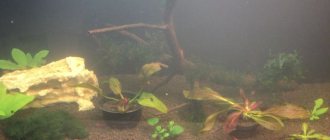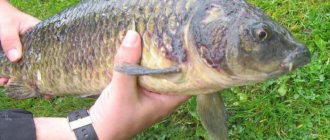. continuation. See the Basics section for a start.
OK, I did everything right, but the algae still grows!
Why can there still be problems with sufficient levels of macro, light and micro? It's all about the link between Light and Macroelements: CO2¬. Without enough carbon, plants cannot consume all the other macro- and micro-carbons, and they go to algae, because they can be content with a minimum of PV in the water, and survive at extremely minimal light levels (>). Plants reduce their growth rate several times as soon as there is a lack of CO2 - the rate of plant photosynthesis is directly proportional to the availability of CO2¬ (see also Ole Pedersen¬ test). “Good plant growth = no algae. In an aquarium with well-growing aquatic plants, algae has virtually no chance. Nutrients that promote algae growth, such as phosphates and nitrates, are immediately absorbed by the plants. However, when there is a lack of CO2, plants immediately give a signal. Excess nutrients are no longer consumed by plants quickly enough. This is a chance for algae, because... they only need a minimal amount of CO2. That is why a large number of plants and a stable supply of CO2 are the most important measures to prevent algae.” (Dennerle)
Finding out why the imbalance occurred = algae starts by looking for a large release of ammonium NH4¬ - the main stimulator of an algae outbreak.
The reasons for the release of NH4 can be: - stopping the growth of plants due to lack of nutrition - poor filter performance - silting and rotting of the substrate - the use of rotting highly labile organic matter in the substrate - the use of a too anaerobic substrate - insufficient water changes - overcrowding of the aquarium with fish and/or insufficient biomass plants or their growth rates.
Then they find out what exactly the plants lack for good growth in order of priority: Light - CO2 - K - NO3 - PO4 - microelements.
Light stability, macro and micro doses, and water changes are as easy as pie. The range of optimal concentrations is very wide - the main thing is that there is no shortage of them. With CO2 things are a little more complicated. The reason is not your negligence. This is caused by the rapid removal of CO2 from water, and the difficulty of controlling CO2 concentrations. Previous methods were very unreliable because they showed only pH and not CO2 concentration, and relied on amateur aquarium tests which are extremely inaccurate. As a result, you often think that there is enough CO2, but in fact there is not. Controlling the CO2 supply is the most difficult element to control in the entire planted aquarium technique. In 90% of cases, algae growth is caused by this.
The simplest and most effective solution to the problem is to make a drop checker with a calibration solution with KH=4.0¬. You will always see what the CO2 concentration is in the aquarium, and not just the pH. This problem can be solved by installing a device that automatically regulates the supply of CO2 - pH controller, but this is a very expensive and difficult to operate device. It's easier to install drop checker.
Lack of nutrition. This is the main reason that a beginner cannot get rid of algae (usually filamentous and Oedogonium). They gave us CO2 and enough light, but the algae just won’t go away. The reason is insufficient plant growth rate and low biomass due to a lack of macro NO3 and PO4¬. Give the plants enough nutrition and they will quickly crowd out the algae. Lack of nutrition is what most often prevents beginners from mastering the planted aquarium technique. You supply CO2, the plants began to grow rapidly, but after a week or two they stopped and began to become covered with holes, the leaves change color. All these are signs of deficiency, macro and micro. Supplying CO2 and good light will radically enhance plant growth, but with a lack of nutrition, after a short-term improvement, growth will inevitably stop, and as a direct consequence you will get an algae outbreak. Instead of giving normal nutrition to the plants (macro and micro), having a poor substrate in the aquarium, they begin to change the water, which further reduces the amount of nutrition - this way the algae will NEVER go away! To stop the growth of algae, you need to increase water changes to remove excess ammonium and organic matter AT THE SAME TIME while adding half the dose of macro- and microelements. Once the plants have improved growth, you can reduce water changes to normal and begin applying a full dose of fertilizer. As long as fertilization and CO2 supply are sufficient, the algae will not return.
Oedogonium. (“fluff” on plants) The first sign of nutritional deficiency is Oedogonium¬. It appears first in long-stemmed plants. This is an early warning of macro deficiency. Watch him closely! The surest sign of PO4 deficiency is the appearance of green spot algae.
Water changes. Another common mistake is getting rid of small(!) algae outbreaks with water changes WITHOUT feeding the plants. Water changes are increased in order to reduce the concentration of the main cause of algae growth - dissolved (DOC) and suspended organic matter and ammonium NH4¬, and not the micro and macro necessary for plant growth! If during this period the macro and micro levels are practically zero, how do you think plants should grow? They simply have nothing to “eat”! Apply at this time half the dose of the normal micro and macro levels (since the plants are not growing well yet), and in a couple of weeks everything will be fine. The algae will be deprived of nutrition, and the plants, gradually improving their growth, will displace them. Guaranteed. In case of severe algae outbreaks, for example when starting an aquarium, the opposite is true: the plants need to consume all the nutrients from the water as quickly as possible, so water changes are done WITHOUT adding nutrition. In both cases, you can do without adding nutrition to the water ONLY if you have a rich substrate. To eliminate the imbalance in individual elements without an algae outbreak, do water changes with a weekly dose of nutrition for each large water change - see “Reboot”. With enough experience, you can use a “reboot” in all three cases.
Kinds
Very often, all aquatic plants are called algae, but there is a significant difference between them. Higher aquatic plants have a complex structure; their body is divided into various sections - roots, stems, leaves and so on.
Did you know? Filamentous
algae live in all bodies of water where there is stagnant water - for example, in artificial reservoirs or swamps.
The phenomenon of water bloom occurs due to their abundant growth. Algae themselves belong to more primitive forms: even if they are large in size, they consist of one type of cell, without a clear division into tissues and organs. Filamentum is the popular name for algae that form long thin threads. Having settled in an aquarium, it becomes a serious competitor for other aquatic plants.
There are several main varieties of filamentous greens:
- edogonium;
- Cladophora;
- spirogyra;
- Rhizoclonium.
Each of them has its own preferences regarding living conditions.
Find out what aquarium algae are.
Edogonium
This type of filament is the most common. When Oedogonium first appears in the aquarium, it looks more like a small fluff on the stems and leaves of other aquatic plants, but over time it transforms into long green threads.
The appearance of this vegetation is the first sign of depletion of the soil substrate, as well as a lack of nutrition in the aquarium. Under normal conditions, this type of filament is easily replaced by aquatic plants. However, a decrease in the saturation of water with nutrients makes it a fertile environment for the development of green fluff.
For effective counteraction, it is necessary to use additional nutrition for plants, which will be the best means of combating edogonium. Shrimp and mollies, which feed on this type of algae with great pleasure, will also help in the fight against this thread. However, this is rather an additional method.
Important! The main mistake that novice aquarists make when faced with Oedogonium is changing the water more frequently. This type of control of parasitic algae will not bring success.
Cladophora
In its structure, this type of filament is more branched. Unlike Oedogonium, Cladophora does not have long filaments, and it is formed in places where water circulates poorly or is poorly filtered, and its stagnation is also observed.
The most effective way to combat these algae is to remove their accumulations from the aquarium manually, or use algaecides (agents for destroying unwanted algae).
But it is also worth reviewing the water circulation system, because the use of mechanical or chemical methods will not prevent the reappearance of cladophora. The main thing in the fight against this type of algae is to eliminate the factors that contribute to its proliferation.
You may find it helpful to read about how to control blue-green algae and diatoms.
Spirogyra
This type of thread is the most undesirable and dangerous for several reasons:
- Firstly, spirogyra looks very ugly - in structure and tactile sensations it looks like green mucus.
- Secondly, its reproduction rate is simply terrifying: if you hesitate a little, your aquarium will be completely filled with spirogyra.
- Thirdly, many algaecides do not help in the fight against these algae, as well as the use of a species of fish such as the Siamese algae eater SAE.
Mechanical removal is considered an effective way to remove spirogyra. Experienced aquarists use combined methods in the fight: collecting these algae with their hands, they also use siphoning of the soil.
As an additional method, shrimp and fish that feed on this plant are used. Also, to eradicate algae, turn off the lights and increase the temperature, which helps slow down the growth of spirogyra.
Important! If your underwater world contains fish such as cichlids, it is especially important for you to take care of the presence of aquatic plants. Artificial water plantings, which are often used to decorate aquariums with these fish, will not be able to prevent the green scourge. Plants should not be neglected also because filamentous algae will take their place.
Rhizoclonium
It occurs in aquariums at the settling stage, when the biobalance has not yet been established. In such aquariums, nitrogen levels have not yet normalized, and the ammonium level is quite high. Unlike the previous variety, rhizoclonium does not pose a significant problem, and after normalization of the nitrogen cycle it disappears.
Shrimp, which are very fond of this algae, will help speed up this process. It is also necessary to do regular water changes. Some experts may recommend algaecides, but their use is not necessary in this case.
Did you know? A low content of filamentous plants in an aquarium is the norm, and also indicates a favorable microclimate for the rest of the aquatic vegetation.
Green plaque on the walls of the aquarium
Xenococcus
Xenococcus - green coating on walls and stones. These algae love a lot of light. Therefore, the problem of green deposits is especially acute in aquariums with high lighting levels. As a rule, these are herbalists with an abundance of long-stemmed species of aquarium plants. In similar aquariums with lighting of 0.5 watt/l, the problem of green deposits is not so significant.
The main reason for the appearance of these algae is a lack of CO2 or large fluctuations in CO2 concentration during daylight hours. Therefore, aquariums equipped with pH controllers are less likely to require glass cleaning to remove these algae. But it is practically impossible to completely avoid the appearance of a green coating on the walls and decorations of an aquarium with a high level of lighting. There are only general recommendations on how to slow down the fouling process:
- Stabilization of CO2 supply;
- Regular water changes;
- Duration of illumination at 1 watt/l is no more than 8 hours.
Theodoxus snails help a lot, and simple physes and coils too. Fish include otocinclus and ancistrus. Learn more about the fight against xenococus.
Reasons for appearance
It is very important to understand why unwanted vegetation began to rapidly spread throughout your aquarium.
There are several main reasons:
- Bright light - exposure to direct sunlight or the use of artificial light for more than 10 hours in a row stimulates the growth of filament.
- Low level of oxygen entering the aquarium.
- The absence or lack of aquatic plants contributes to the development of filamentous algae. In addition, excessive amounts of fertilizer are an additional incentive for their development.
- Poor cleaning of the aquarium, as well as too infrequent water changes lead to the accumulation of nitrates, which the filament feeds on.
Another reason for the appearance of filamentous greens is an excess of microelements. This phenomenon most often occurs in the initial stages of fish breeding, when aquatic plants have not yet taken root. Also, filament can migrate into your aquarium from a pet store.
Why are filamentous algae dangerous in an aquarium?
Although algae seem to be just inconspicuous plants, their harmful effects should not be underestimated.
- In favorable conditions, the filament develops very quickly, during its life activity it releases a large amount of toxins that negatively affect other inhabitants of the underwater world.
- As they grow, the threads envelop other plants, causing their growth to slow down. And when plants begin to die, this gives an additional impetus to the proliferation of filament algae.
- Dense thickets of these plants act as a “filter” on which food residues, mineral supplements, etc. accumulate. As a result, they contribute to rapid clouding of the water and further contamination of the aquarium.
- Not only fry, but also adult fish can become entangled in a cluster of long intertwining threads.
Thus, the issue of combating unwanted algae is always relevant for aquarists.
How to get rid of threads
First of all, you need to analyze the reasons for its appearance in the aquarium. As we already know, these include bright light, insufficient water filtration, poor aquarium cleaning and a lack of plants.
That is why you should check the operation of the filter system and the light level in the aquarium. If it is close to a window and receives direct sunlight, you just need to move it deeper into the room.
Important! When using artificial light, it is important to pay special attention to the color of the lamp. For example, blue light stimulates the growth of filamentous algae, so this lamp must be replaced with another one with softer radiation.
If a large amount of ammonia compounds accumulates in the aquarium, it is necessary to check the filter, which may be clogged. This phenomenon is also observed when there are a large number of inhabitants of the underwater world and in the absence or lack of vegetation.
To eliminate this problem, you can use fast-growing and at the same time floating plants - these include Vallisneria and hygrophiles.
They not only suppress the filament, but also deprive it of nutrition. Particular attention must be paid to the concentration of iron, which should not exceed 0.2 mg/l.
If the above methods do not give effective results, you need to move on to more radical ones. The most effective method is the mechanical one - that is, you just need to remove the accumulations of threads manually.
Did you know? Filamentum, unlike other algae, has a sweetish taste and a specific smell.
This method of control can be combined with a chemical one, when glutaraldehyde or hydrogen peroxide is added to the water. If you use the latter substance, then it must be added in a ratio of 6–10 mg/l, depending on the degree of contamination of the aquarium.
Video: how to deal with filament in an aquarium You can purchase specially developed products - algaecides, which are sold in any store that sells aquarium supplies.
For example, in the fight against filamentous algae, the drug “AQUAYER AlgoShock” has shown itself to be effective (add 8 ml per 50 liters of water per day for 3 days; if the accumulations are localized in a small area, you can add the solution there using a syringe). The inhabitants of the aquarium themselves can help in the fight against algae scourge. For example, Spirogyra loves to eat shrimp.
To combat unwanted algae in an aquarium, use the disinfectant Sidex.
Other assistants in this difficult matter can be:
- ancistrus;
- Gerinocheilus;
- otocinclus;
- Siamese algae eater;
- Neretina snails, which cleanse plants of unwanted settlers.
The most common mistake
Many aquarium owners are afraid to add fertilizers because they believe that they are the cause of the appearance of filament. This deprives the algae of all the nutrients it needs to grow.
On the products of many manufacturers you can notice an interesting statement: “Free from nitrates and phosphates.” Thus, they hint at the reason for the development of threads, without even thinking about it.
However, these same components are simply necessary for them and are the main macroelements. They are food for plants in the aquarium. The unhealthy appearance of algae and poor development are precisely the result of a lack of macroelements in the body. When a problem like this occurs, the growth of aquarium plants slows down and unwanted plants appear.
It turns out to be an interesting situation. Fish lovers are afraid for the “well-being” of all the inhabitants of the aquarium and flatly refuse to add those same nitrates and phosphates. Such actions are wrong. You just need to do the opposite. Macroelements are one of the best means of restoring the normal state of aquarium plants.

